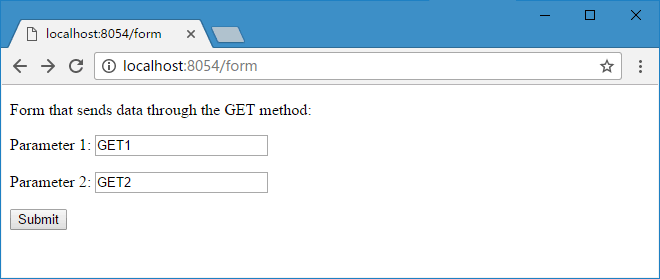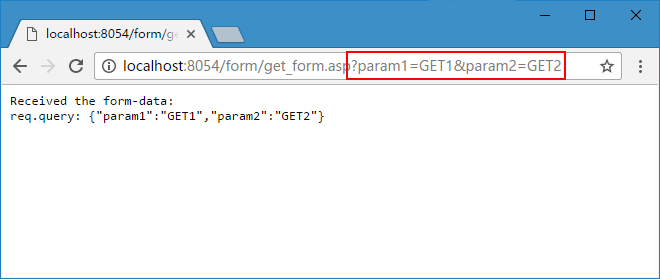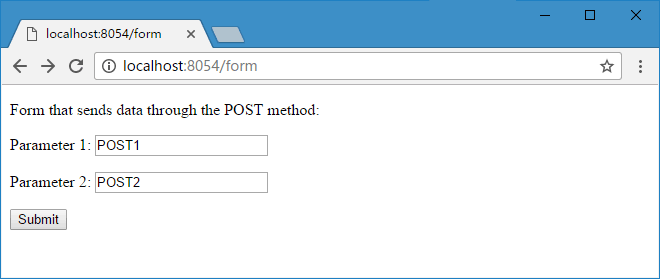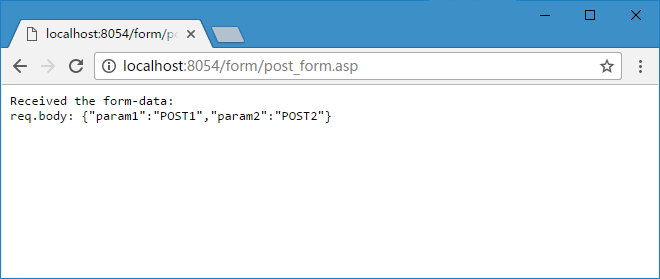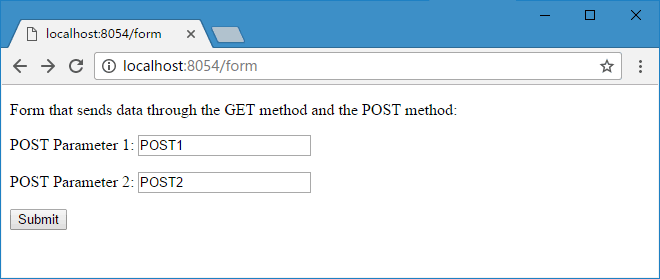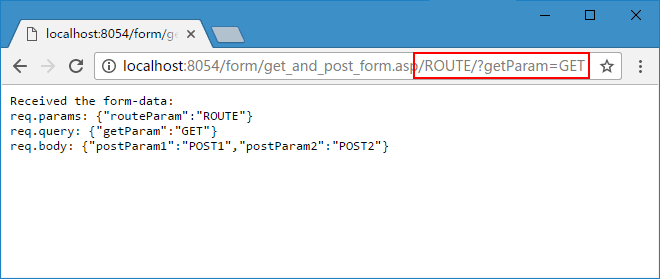在互联网上, QueryString 是地址的一部分, 其中包含着需要传给后台的数据,通常以 '?' 开始,以 '&' 号分割,如 "/form/get_form.asp/?param1=1234$param2=5678"。在表单提交时,会默认以 QueryString 的形式向后台发送数据,OnceIO 会将其存储在 req.query 对象上。
在项目文件夹中创建服务器文件 websvr.js 和网页文件 form.html。
websvr.js 的代码如下:
var onceio = require('../onceio/onceio')
var app = onceio({
home : "./"
, port : 8054
, listDir: true
, debug : false
})
app.get('/form', function(req, res) {
res.render('form.html')
})
//Handling form-data sent through the GET method
app.get('/form/get_form.asp', function(req, res) {
res.write('Received the form-data:\n')
res.send('req.query: ' + JSON.stringify(req.query))
})
form.html 的代码如下:
<!DOCTYPE html>
<html>
<body>
<p>Form that sends data through the GET method:</p>
<form action="/form/get_form.asp" method="get">
<p>Parameter 1: <input type="text" name="param1" value="GET1" /></p>
<p>Parameter 2: <input type="text" name="param2" value="GET2" /></p>
<input type="submit" value="Submit" />
</form>
</body>
</html>
运行服务器,在浏览器中打开 localhost:8054/form,得到以下结果:
点击提交后,浏览器显示出服务器收到的包含在 req.query 中的表单数据,地址栏中的 URL 也显示了表单中所有参数的名称和值:
GET 将数据放在地址中,而地址中存放的数据量是有限的。POST 则将数据存储在 Request Body 中。OnceIO 将 POST 接收的数据存放在 req.body 中。
将 websvr.js 文件中的 app.get('/form/get_form.asp', function(req, res)) 函数替换为:
//Handling form-data sent through the POST method
app.post('/form/post_form.asp', function(req, res) {
res.write('Received the form-data:\n')
res.send('req.body: ' + JSON.stringify(req.body))
})
将 form.html 文件中 body 里的内容替换
<p>Form that sends data through the POST method:</p>
<form action="/form/post_form.asp" method="post">
<p>Parameter 1: <input type="text" name="param1" value="POST1" /></p>
<p>Parameter 2: <input type="text" name="param2" value="POST2" /></p>
<input type="submit" value="Submit" />
</form>
重启服务器,在浏览器中打开 localhost:8054/form,得到以下结果:
点击提交后,浏览器显示出服务器收到的包含在 req.body 中的表单数据,而地址栏不显示任何表单数据:
用户还可以将路由的一部分指定为变量,如 "/form/get_and_post_form.asp/:routeParam"。OnceIO 会将 routeParam 变量的值存放在 req.params 中。
app.url 接口可以让 GET 与 POST 同时使用。将 websvr.js 文件中的 app.post('/form/post_form.asp', function(req, res)) 函数替换为:
//Handling form-data sent through the GET method and the POST method
app.url('/form/get_and_post_form.asp/:routeParam', function(req, res) {
res.write('Received the form-data:\n')
res.write('req.params: ' + JSON.stringify(req.params) + '\n')
res.write('req.query: ' + JSON.stringify(req.query) + '\n')
res.send('req.body: ' + JSON.stringify(req.body))
}, 'qs')
为减少 I/O,app.url() 默认不加载 req.body,如需加载,需要把它的第三个参数设置为 'qs' 或 {POST : 'qs'}.
将 form.html 文件中 body 里的内容替换为:
<p>Form that sends data through the GET method and the POST method:</p>
<form action="/form/get_and_post_form.asp/ROUTE/?getParam=GET" method="post">
<p>POST Parameter 1: <input type="text" name="postParam1" value="POST1" /></p>
<p>POST Parameter 2: <input type="text" name="postParam2" value="POST2" /></p>
<input type="submit" value="Submit" />
</form>
这个表单同时使用了三种传送数据的方法:在表单的 action 属性中以 '/' 分隔开 URL 参数将其传送到 req.params 中;在表单的 action 属性中以 '?' 标示 URL 参数将其传送到 req.query 中;用 POST 方式将表单内的输入项传送到 req.body 中。
重启服务器,在浏览器中打开 localhost:8054/form,得到以下结果:
点击提交后,页面显示出服务器收到的分别包含在 req.params,req.query 和 req.body 中的表单数据,而地址栏中的 URL 只显示了 req.params 和 req.query 中的数据:
